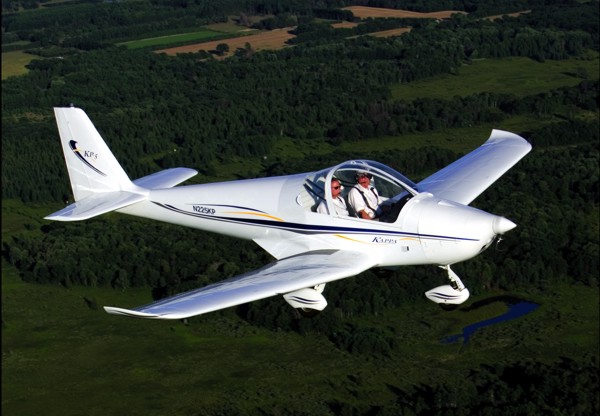
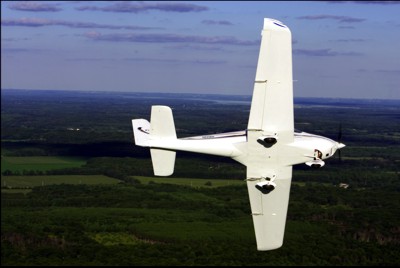
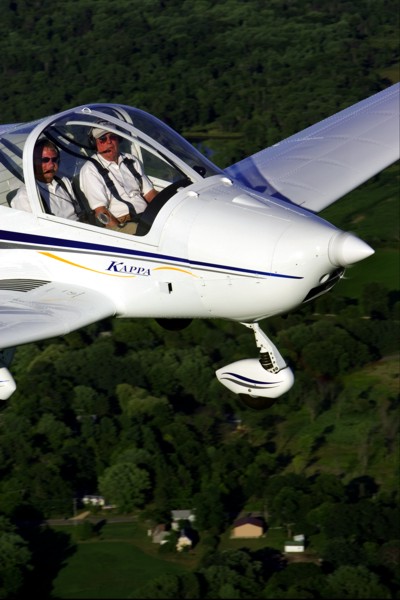
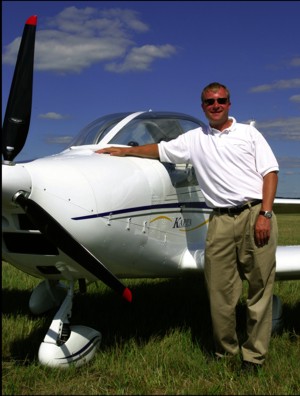
Edwin Miller III is leading
the charge to bring the
Kappa KP-5 to the U.S.
marketplace.
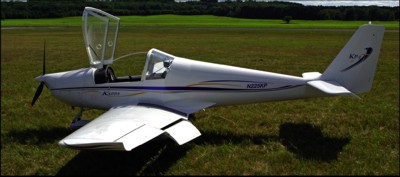
The all-metal, low-wing KP-
5 with its massive Fowler
flaps deployed. Note the
up-turned wingtips used
to maintain airflow contact
over the full surface of the
wing. The cantilever-winged
aircraft features a flip-forward
canopy makes entry
and exit relatively easy.
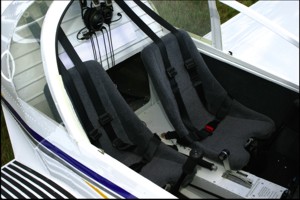
The seats of the KP-5 are
staggered, with the right
seat approximately eight
inches aft of the left seat,
offering extra shoulder
room. The throttle and
flap controls are located
in the center console.
The area aft of the seats,
which flips forward for
access to the area, can
accommodate up to 66
pounds of baggage. U.S.
buyers also have the
option to purchase a customized
interior.
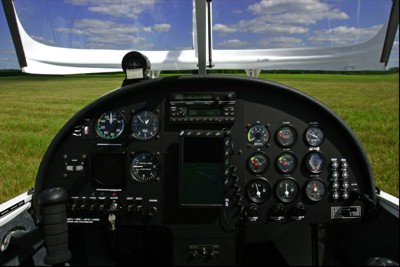
The KP-5 comes
standard with a
full complement
of instruments;
however the
moving map
(center) and attitude
indicator
(angled area at
left) are options.

A Glimpse at the S-LSA Certification Process
Kappa’s KP-5 … a great trainer and more!
At EAA AirVenture Oshkosh
2005, 13 aircraft on
display in the Light-Sport
Aircraft (LSA) Mall-
which put LSA on center
stage just south of AeroShell Square-
had their airworthiness certificates as
special light-sport aircraft (S-LSA). (A
14th aircraft, the Savage Cub, exhibited
in the North Commercial Area,
also earned its S-LSA certificate, but
only had one aircraft to display.) That
14 aircraft earned S-LSA certificates
in the short span of three and a half
months since the FAA announced
the availability of the final consensus
standards for LSA-category airplanes
is an unprecedented accomplishment.
No one can recall when so many airplanes
have been certificated in such
a short time.
One of those baker’s dozen plus
one is the Jihlavan (pronounced
“YEE-la-von”) KP-5, better known to
Americans by its importer’s name-
Kappa Aircraft KP-5. It is an elegantly
styled, all-metal LSA with a high-visibility
cockpit, a high-performance
wing with well-regarded Fowler
flaps, tough trailing link landing
gear, and the popular Rotax 912
powerplant. In its ready-to-fly form,
the KP-5 sells for about $88,500. But,
Edwin Miller, president of Kappa
Aircraft based in Pocono Pines,
Pennsylvania, says interested buyers
should check with his staff to determine
the current price depending
upon the euro exchange rate.
Rising From the Fall
Like many contemporary Eastern
European producers, Kappa 77, a division
of Jihlavan, started life as an aircraft
manufacturing facility after the
Soviets left the Czech Republic. It took a
few years of difficult adjustment before
countries like the Czech Republic began
to rebuild private businesses, which
had existed widely before the Soviet
occupation.
Kappa 77 and Jihlavan worked
together to produce the KP-5 that Kappa
Aircraft distributes to American buyers
as an S-LSA. Jihlavan, a 250-employee
component manufacturer specializing
in aeronautical hydraulics and actuators,
had always provided the facility
and workers for Kappa. It began assisting
Kappa 77 financially in 1998; in late
2004, when Kappa 77’s financial difficulties
increased, the larger company
purchased all design rights and continued
production of Kappa’s aircraft.
About 90 employees are involved in the
Jihlavan airplane division. Ed said, “All
the same employees are making Kappa
airplanes, so we have labor continuity.”
(Jihlavan manufactures components for
Boeing, General Electric, SAAB, and
many more aerospace companies. Since
organizing in 1952, Jihlavan has built
parts for MiGs, L-39s, and many other
aircraft.)
Antonin Pistek, the chief designer for
the KP-2U Sova, an airplane much like
the KP-5 but with retractable gear, also
led the design team for the KP-5. As it
happens he is also leading the design
of Evektor’s VUT 100 Cobra, a five-seat
general aviation aircraft that made its
debut at Aero 2005 in Friedrichshafen,
Germany, earlier this year and was displayed
at EAA AirVenture by Evektor
importer, Sport Aircraft International of
Kerrville, Texas.
The Americanized Kappa KP-5
For the U.S. market, Jihlavan had a
delicious opportunity. It could increase
the aircraft’s gross weight above any previous
limits allowed (by regulation) in
countries where the airplanes are sold.
In Australia, the KP-5 is approved to a
maximum takeoff weight of 544 kilograms,
or 1,199 pounds, which is what
Kappa Aircraft uses for its
S-LSA version. Limited to
120 knots maximum speed
(138 mph), the fixed-gear
KP-5 with wheelpants fits
the LSA rules well and is
less complex to operate,
exactly as the FAA intended
for LSA.
As Americans have
looked over the allmetal,
low-wing KP-5 at
air shows and on Sport
Pilot Tour stops, everyone seems to
notice its distinctive Fowler flaps first.
Jihlavan’s engineers, led by Pistek,
extended the aircraft’s Fowler flaps
well beyond the wing’s trailing edge,
adding considerable square feet of
area. The flaps also arc downward
with a smooth gap to supply optimal
airflow over the surfaces.
The flaps are controlled via mechanical
linkages and are quite effective
with 10 and 35 degrees of deployment
guided by a track arrangement.
In flight you can see and feel the
effect of their moving aft to the first
notch; then you sense a noticeably
separate action as they descend to the
second position.
Switches on either the left or right
joystick operate electric in-flight trim-
but not both to avoid pilots simultaneously
moving that control. As is often
the case when installed in this location,
the switch offers a fairly fast response
rate so you hit the button a series of
times but rarely hold it down. A small
indicator mounted to the left of the airspeed
indicator on the far left side of the
instrument panel provides a good visual
display of which way you’re moving
the trim. You also can feel the effects of
trim quickly, which is good because the
indicator is not a ready glance for pilots
in the right seat.
Each joystick also has a push-to-talk
switch allowing you to keep your hand
where it belongs during takeoffs and
landing. Across the panel all electric
switches are guarded to prevent their
inadvertent movement.
The KP-5’s panel clearly has room for
any instruments that pilots may wish
to have. A moving map instrument in
the center of the panel offers pilots the opportunity to use the latest technology,
and an angled space in front of
the left-seat pilot is intended to hold
attitude indicator.
The throttle lever, which is located
between the seats in a center console
(along with the flap handle), was a
bit of a reach from the right seat,
which sits aft of the left seat by about
8 inches. However, typically, the leftseat
pilot will handle most throttle
action, and the reach from that seat
is reasonable.
That staggered seating allows each
pilot to see well left and right and gives
the left-seat pilot a definite pilot-incommand
feel, which should work well
for instructors to instill confidence in
their students. It also ensures that two
large people won’t be constantly rubbing
shoulders. And, it allowed the KP-
5’s engineers to keep the cabin width
narrower, thereby improving performance
and fuel consumption. Some
may not care for this arrangement, but
it has clear benefits. (Earthstar Aircraft’s
Odyssey uses a similar seating arrangement
for the same reasons, and owners
of that aircraft have appreciated the
extra room.)
The KP-5’s cloth-covered seats,
though not heavily padded, proved
quite comfortable. Four-point seat
belts are standard, and the whole interior
has a carpeted finish; simple, but
nicely achieved. Ed advised that a
new seat design that is shaped better
to the human form is used in
later model KP-5s. For the American
market, Jihlavan Airplanes will supply
aircraft to Kappa without interior
appointments. AirTex of Fallsington,
Pennsylvania, will provide the interior
appointments to allow greater customization
for American buyers.
Visibility through the KP-5’s large,
aft-latching canopy is broader than it
may appear, even to the aft. In the heat
of Florida, where I flew the aircraft, the
cabin didn’t warm up uncomfortably
thanks to air inlets. Future KP-5s will be
supplied with a tinted canopy.
The canopy latches fore and aft,
making for a secure closure. In the
aircraft I flew, the latch control was on
the left side, but it has been redesigned
and mounted instead on the overhead
canopy support with pins that secure
the sides of the canopy. Now, it can
be opened or closed with one motion,
and either occupant can reach the
latch handle.
The KP-5 has a large baggage area
capable of holding 66 pounds aft of
the seats, which flip forward for easy
access to the area. A lever between your
legs adjusts the seat position to eight
different locations. Using a technique
similar to removing a drawer from a
desk, you can easily remove either seat
to fill the cargo area to its maximum
allowed capacity.
During our test flight, Ed offered the
use of his Bose noise-canceling headsets,
and they performed brilliantly.
Ironically, afterward my recorded notes
were difficult to understand because
the engine noise was greater than I
realized, so I didn’t talk as loudly into
my recorder as I frequently do. When I
removed my headset for a short check,
though, the noise level didn’t seem
much different than other airplanes in
KP-5’s class.
A Sweet Flying Experience
However, my recorder did easily capture
this comment I made while Ed
and I flew around central Florida: “The
KP-5 is one of the best handling aircraft
I’ve had the pleasure to fly.” Harmony
in the controls is quite good. Pressures
are light, and response is crisp without
being sudden. Experienced pilots will
appreciate its fine combination of control
ease and authority. Yet, the KP-5
also should make a good trainer; its
sturdy landing gear serves this purpose.
The controls weren’t at fault, but I
tended to raise the nose too much, and
we continuously climbed gently when
I didn’t mind the altimeter. When
the nose is in the proper attitude, it
appears you are beginning a shallow
dive. However, the good visibility over
the nose creates a favorable impression
once you adapt to this positioning.
The 100-hp Rotax 912S engine provided
terrific performance at its near
1,200-pound gross weight. (Ed and I
actually flew at a weight modestly less
than the gross weight allowed.) Climb
rate was 800-900 fpm at 2,000 feet MSL
on an 80°F, moderately humid day in
central Florida.
At about 4900 rpm, we were running
115-120 mph. Apparently its lighter
weight and leaner cabin width help the
KP-5 slip through the air easily.
Engine idle sink rate was also good,
averaging about 450 fpm with some
portion of the two-minute test showing
320 fpm, an excellent performance
among light aircraft (and noticeably
better than most GA aircraft).
The KP-5 designers report that with
retractable gear and an adjustable prop,
the aircraft’s glide ratio can reach 18-
to-1. Of course, with its fixed gear and
prop, the LSA version performs closer
to 14-to-1. Regardless, the KP-5 clearly
stretches a glide well and sinks slowly.
Every one of my landings in the KP-5
went exceedingly well; I credit the airplane
more than my technique. Given
the combination of a low sink rate with
effective flaps and good, low-speed handling,
the KP-5 accommodates takeoffs
and landings with ease.
During the flight, I performed
approach and departure stalls plus
accelerated stalls. Most of them fell to
the right a little faster than I’d consider
optimal, but recovery was always easy.
In no case did I require any power to
recover from a stall with minimal altitude
loss.
After noting the right-hand break, I
paid extra attention when I did accelerated
stalls to the right. But even with
the wing bank at about 45 degrees, the
KP-5 rolled out level, confirming the
reasonable stall characteristics of this
airplane. My speculation is that this
good quality may result from slipstream
effect on the tail.
In accelerated stalls, a pronounced
burbling identified incipient stall. This
was less evident in straight-ahead stalls,
but when the nose fell through, it
proved quite a benign action.
All stalls came at low speeds. Given
instrument error at the bottom of the
range, I don’t know if I can believe the
38 mph indicated. This represents only
33 knots, making it 12 knots slower
than the maximum for LSA. Regardless
of the actual numbers, it’s clear the KP-
5 stalls very slowly, a great attribute for
an instructional aircraft. All stalls were
done without using the superb Fowler
flap system.
Although the KP-5 slows down well,
as proved by my experience, controls
remain responsive right down to minimum
flying speeds. With those Fowler
flaps extended well aft, Kappa seemed
content flying at 45 mph.
You may deploy the flaps at 68 mph.
However, deploying them requires a
physical effort to get to the second
notch. My in-flight recorded notes
reflected that I had to yank on the lever
to engage maximum flaps. A better
technique would help and perhaps a bit
of lubrication was needed. And, I may
have been deploying them at a speed
slightly higher than the recommended
68 mph. Design engineers noted that
the use of mechanical actuation keeps
pilots from too easily lowering the flaps
above that recommended speed.
Fuel, your choice of low-lead avgas
or high-test auto gas sources, is stored
in 8.5 gallon tanks in each wing. You
can add two more 4-gallon tanks for
a total of 25 gallons, which equates
to more than five hours of range and
could take you as far as 750 miles on the
aircraft’s 4 to 4-1/2 gph burn rate. You
can switch between the KP-5’s tanks
in flight, which is unusual in an LSA,
allowing pilots to burn one side more
than the other to aid lateral balance.
I was impressed with how well the
engine installation provides good cooling.
We flew in Florida in late October,
and conditions were still warm and
humid. Never did I note the oil or
cylinder head temperatures rising into
the higher green ranges. When flying
in colder months, Ed uses some baffling
to keep temperatures in range.
The engine installation also succeeds at
isolating vibration from the Rotax 912S
powerplant.
Toe brakes are installed only at the
left-seat position-or the right if preferred-
but not both due to limitations
in the hydraulic reservoir. To date, most
American customers have ordered an
optional handbrake mounted on one
or both joysticks. The handbrake is also
hydraulic. If buyers choose this option,
the rudder pedals can be adjusted for
greater seating versatility.
Catch a KP-5
At the KP-5’s selling price in the
neighborhood of $88,500, you get many items as standard equipment,
including: two hours of orientation
flying; an Icom 200 radio and antenna;
basic VFR flight instruments and basic
engine instruments; an ELT (required
on an LSA but not always included
in the base price); hydraulic brakes;
dual controls; cockpit lock; electric
trim; two (tail and belly) anti-collision
lights; fuel gauges; fuel pressure
gauge; oil temp; tachometer; oil pressure;
CHT; battery recharging indicator;
12-volt socket; engine hour meter;
VSI; altimeter; ASI; compass; and bank
indicator. Of course you can add more
accessories or finish your interior more
expensively, but the base price airplane
provides all you need.
Fortunately, Jihlavan’s production
capacity should allow many of
these wonderful airplanes to arrive in
America. Based on what I’ve seen from
mixed audiences of new, returning, and
current pilots, the low-wing KP-5 is well regarded-at least by those not put off
by the staggered seating. Those who
prefer high-wing airplanes have other
choices, but in the low-wing, all-metal
sweepstakes, Kappa has a winner with
this airplane.
Pilots considering a new LSA have
many interesting choices. As important
as the aircraft itself is the stability
of the organization behind the plane
and the people who will support it,
no matter whether it’s imported or
domestic. Unless I miss my guess,
given Jihlavan’s financial stability, the
KP-5 will find a substantial following
in the United States.
| Seating | 2 side-by-side, staggered |
| Empty weight | 695 pounds |
| Gross weight | 1,278 pounds |
| Wingspan | 32.5 feet |
| Wing area | 128 square feet |
| Wing loading | 10 pounds/square foot |
| Useful Load | 583 pounds |
| Length | 23.6 feet |
| Payload (with full fuel) | 481 pounds (standard tanks) 1 |
| Cabin Interior | 47 inches |
| Height | 8.6 feet |
| Fuel Capacity | 17 Gallons )1 |
| Baggage area | 66 pounds including optional hat rack |
| Airworthiness | Certified SLSA |
| Notes: | 1 Optional fuel tanks add 8 gallons, making payload 433 pounds. |
| Standard engine | Rotax 912S |
| Power | 100 hp |
| Power loading | 12.8 pounds/hp |
| Cruise speed | 101 kts/116 mph (75% power) |
| Stall Speed | 38 mph (see article) |
| Never exceed speed | 141 kts/162 mph |
| Rate of climb at gross | 1,100 fpm |
| Takeoff distance at gross | 300 feet |
| Landing distance at gross | 450 feet |
| Range (powered) | 4 hours, 450 miles 1 (no reserve) |
| Fuel Consumption | about 4 gph |
| Notes: | 1 Range with optional fuel tanks, 650 miles. |
| Standard Features | Rotax 912 with electric starting, VFR panel instruments, engine instruments, Garmin SL 40 radio and transponder, fuel boost pump and quantity gauges, fuel selector, 3- blade prop, sliding canopy (cannot be opened in flight), hydraulic brakes, electric flaps and pitch trim, dual controls, 4-point pilot restraints, entry doors on both sides, staggered seating. |
| Options | Additional instrumentation including glass displays, radio choices, lighting package, long-range fuel tanks, Garmin GPS mount, custom paint, BRS ballistic parachute, leather interior, covers. |
| Construction | Aluminum semimonocoque airframe, all-aluminum wing and surfaces, steel cockpit reinforcements. Made in Czech Republic; distributed by U.S.-based importer (Pennsylvania). |
Design
Cosmetic appearance, structural integrity, achievement of design goals, effectiveness of aerodynamics, ergonomics.
Pros – Sleek, low-wing entry redone in ’06 to better
suit the model to Americans. Further upgraded in early
’08. Wider, roomier, better equipped, and needed electric
flaps. The Skyleader 500 is one of the top LSA contenders
by design sophistication and meeting design
goals in ways unlike other LSA.
Cons – To reach such a capable design, Jihlavan
developers didn’t follow standard methods; minor controls
can be counterintuitive. Production volumes are
not high for the Skyleader 500 (though rising, says
Skyleader); only a couple dozen on U.S. registry. Some
repairs will require long travel due to low (though
growing) number of representatives in a big country.
Systems
Subsystems available to pilot such as: Flaps; Fuel sources; Electric start; In-air restart; Brakes; Engine controls; Navigations; Radio; (items covered may be optional).
Pros – Electric trim and flaps are standard and
work well. Electric trim was especially effective and
Fowler flaps are a joy. Hydraulic brakes, usually
ordered with hand lever, were effective; toe brakes
optional at either seat. Dual wing tanks; can be
increased for good range.
Cons – Control buttons on the joystick were not
fully intuitive; same for starter button on throttle.
Thank goodness for electric flaps; former mechanical
lever were difficult. Engine access involved cowl
removal (though new hinged doors make this easier).
Control reach from further-aft right seat presents some
drawback (though new seating should improve this).
Cockpit/Cabin
Instrumentation; Ergonomics of controls; Creature comforts; (items covered may be optional).
Pros – Wing-based entry eased, as you can stand
upright on the floor. Four-point pilot restraints. Bigger
occupants may truly appreciate the roominess afforded
by staggered seating (though now being changed).
Seating allows an unobstructed view out each side for
each occupant. Heating and cooling vents provided
standard. Seats adjust in flight.
Cons – Staggered seats are less optimal considering
control reach for the right seat occupant (though
side-by-side now standard). Panel readability also suffers
somewhat. Lower-hanging rudder pedals may not
work for everyone. Entry on the wing is problematical
for less limber pilots.
Ground Handling
Taxi visibility; Steering; Turn radius; Shock absorption; Stance/Stability; Braking.
Pros – Visibility is very good over the sloped
Skyleader 500 nose; true on the ground or in flight.
Staggered seating provides lateral visibility for both
occupants. Trailing link suspension absorbs loads well.
Hydraulic braking was effective (toe brakes optional;
tested with hand lever). Good clearance for turf fields.
Cons – Hand brakes don’t please everyone (toe
brakes are available for those pilots). The Skyleader
500 turns well, but not so sharply as a freely castoring
nose- or tailwheel. Nondifferential braking lessens taxi
maneuverability (toe brakes fix this at optional cost).
Takeoff/Landing
Qualities; Efficiency; Ease; Comparative values.
Pros – Ground roll on takeoff was short (300 feet,
per factory). Takeoff and landing visibility are excellent
over sloped nose. Approach speeds can be held low, 40
mph with practice, thanks to Fowler flaps which
enlarge wing area. Excellent trailing link suspension
system absorbs hard landings with ease.
Cons – You can raise the nose so high allowing flow
separation and hard touchdowns (though experience
will cure this quickly). Slips were modestly effective.
Long glide (14:1) makes for longer touchdowns than
takeoffs and encouraged too-high nose landings.
Control
Quality and quantity for: Coordination; Authority; Pressures; Response; and Coupling.
Pros – One of the Skyleader 500’s outstanding features
is handling – precision, ease, lightness but not too
light or squirrelly; few will find any fault in this category.
Coordination was excellent. Precision turns to
headings were accurate from the start and the
Skyleader 500 holds a steep bank turn easily with a bit
of power.
Cons – The sloped nose that improves visibility
requires some familiarization to hold level attitude.
Climbing turns result from inattention to this characteristic.
No other negatives.
Performance
Climb; Glide; Sink; Cruise/stall/max speeds; Endurance; Range; Maneuverability.
Pros – While not the top-speed performer among
LSA, the Skyleader 500 offers a well-rounded package.
Flies brilliantly at low power settings even without
Fowler flaps and more so with full deployment. Sink
rate was good at about 500 fpm. Long glide capability
(14:1, says factory) aiding any low-approach situations.
Cons – Those flying long cross-country flights may
yearn for a few more miles an hour (though even the
138-mph max speed isn’t high for extended flights).
Landing distance (450 feet), a result of the long glide, is
not optimal for the shortest strips (though a slow
approach will work at most fields).
Stability
Stall recovery and characteristics; Dampening; Spiral stability; Adverse yaw qualities.
Pros – Power-off stalls broke clearly but modestly
at very low speeds. Accelerated stalls rolled to level
from both directions. Longitudinal stability tests were
good with quick recovery to level flight. Power stability
checks showed proper responses. The Skyleader 500
could work for less experienced pilots.
Cons – Tendency noted in two KP-5 aircraft (wide
body and earlier) to fall to the right more abruptly than
considered optimal (though recovery was never in
doubt). Adverse yaw was about as expected. No parachute
installed on test airplane, though Kappa does
offer the equipment.
Overall
Addresses the questions: “Will a buyer get what he/she expects to buy, and did the designer/builder achieve the chosen goal?”
Pros – Upper-range LSA choice that flies and performs
excellently. Good flight school or recreational use
aircraft. Handles well at slow speeds. Sturdy construction
made more robust in ’06. Base-price model well
equipped. Importer has close connection to Czech factory
and has an established U.S. presence.
Cons – an established U.S. presence.
CONS – Premium price may limit resale market.
Holds a smaller market share, which may give some
buyers pause, potentially affecting resale. Fewer dealer
outlets than larger selling brands. More expensive than
several other LSA designs.


We need information on installing a GTX 345 In a KP5 Skyleader.
KP5 and Skyleader, while originating from the airframe, were produced by different companies. The KP5 has been out of production for some time. However, Skyleader North America may be able to help.